Never Ending Tour
The Never Ending Tour is the popular name for Bob Dylan's endless touring schedule which began on June 7, 1988.[2][3] During the course of the tour, musicians have come and gone as the band has continued to evolve. The tour has amassed a huge fan base with some fans traveling from around the world to attend as many Dylan shows as possible.[4]
| World tour by Bob Dylan | |
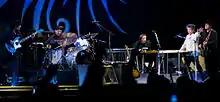 Bob Dylan and his Band, Spectrum, Oslo, Norway, March 30, 2007 | |
| Location | North America Europe South America Australia Asia Central America |
|---|---|
| Start date | June 7, 1988 |
| Legs | 135 |
| No. of shows | 3,066 (as of December 8, 2019)[1] |
According to Swedish researcher Olof Björner[5], Dylan played his 2,000th show of the Never Ending Tour on October 16, 2007, in Dayton, Ohio.[6] He played his 3,000th show of the Never Ending Tour on April 19, 2019, in Innsbruck, Austria.[1] Dylan has attributed much of the versatility of his live shows to the talent of his backing band, with whom he recorded each of his 21st Century studio albums: Love and Theft (2001); Modern Times (2006); Together Through Life (2009); Christmas in the Heart (2009); Tempest (2012); Shadows in the Night (2015); Fallen Angels (2016); Triplicate (2017) and Rough and Rowdy Ways (2020).
Name
The tour's name was cemented when journalist Adrian Deevoy published his interview with Dylan in Q Magazine no.39, December 1989. The critic Michael Gray listened to Deevoy's interview tape, and points out in The Bob Dylan Encyclopedia that though Deevoy's article put the phrase into Dylan's mouth, in fact the label came from Deevoy in the following exchange:
- AD: 'Tell me about this live thing. You've gone straight into this tour again — one tour virtually straight into the next one.'
- BD: 'Oh, it's all the same tour.'
- AD: 'It's the Never Ending Tour?'
- BD: (unenthusiastically) 'Yeah, yeah'.[7]
Dylan has been dismissive of the Never Ending Tour tag. In the sleeve notes to his album World Gone Wrong (1993), Dylan wrote:
Don't be bewildered by the Never Ending Tour chatter. There was a Never Ending Tour but it ended in 1991 with the departure of guitarist G. E. Smith. That one's long gone but there have been many others since then: "The Money Never Runs Out Tour" (Fall of 1991) "Southern Sympathizer Tour" (Early 1992) "Why Do You Look At Me So Strangely Tour" (European Tour 1992) "The One Sad Cry Of Pity Tour" (Australia & West Coast American Tour 1992) "Outburst Of Consciousness Tour" (1992) "Don't Let Your Deal Go Down Tour" (1993) and others, too many to mention each with their own character & design.
In a 2009 interview with Rolling Stone magazine, Dylan queried the validity of the term Never Ending Tour, saying:
Critics should know there is no such thing as forever. Does anybody call Henry Ford a Never Ending Car Builder? Anybody ever say that Duke Ellington was on a Never Ending Bandstand Tour? These days, people are lucky to have a job. Any job. So critics might be uncomfortable with my working so much. Anybody with a trade can work as long as they want. A carpenter, an electrician. They don't necessarily need to retire.
The tour was briefly interrupted in the spring of 1997 when Dylan was forced to cancel dates after suffering a serious medical issue in May. CBS Records announced he was being hospitalized for a potentially fatal chest infection, histoplasmosis,[8] but Dylan resumed touring that fall.
Performances in Japan and the US were cancelled during 2020 due to the COVID-19 pandemic.
Books, live recordings and broadcasts
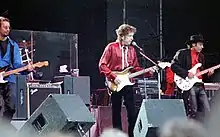
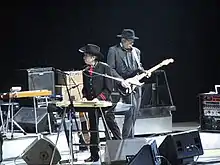
Andrew Muir published Razor's Edge: Bob Dylan and the Never Ending Tour in September 2001. The book chronicles the first fifteen years of Dylan's Never Ending Tour from the point of view of a committed fan of the Tour, analysing how Dylan varies his interpretations of his songs, and exploring Dylan's possible motivations. In July 2013, Muir updated Razor's Edge when he published One More Night: Bob Dylan's Never Ending Tour: this book covers Dylan's touring activities from 1988 to 2011.
The only complete live album of material recorded with the Never Ending Tour band is MTV Unplugged, recorded in 1994 and released in 1995.
In 1994, Bob Dylan's performance of "Highway 61 Revisited" was recorded at Woodstock '94 and released on CD and VHS.
In 2001, Sony released Live 1961–2000: Thirty-Nine Years of Great Concert Performances which included six songs recorded on the Never Ending Tour between 1994 and 2000. The songs were: "Somebody Touched Me", "Dignity", "Cold Irons Bound", "Born in Time", "Country Pie" and "Things Have Changed".
Dylan's performance of "Down Along the Cove" from the Bonnaroo Music Festival 2004 was released on the Bonnaroo 2004 CD by Sanctuary Records in 2005.
Spanish TV station TVE2 broadcast three songs, "It Ain't Me Babe", "Rollin' and Tumblin'" and "Just Like Tom Thumb's Blues", from the concert that Dylan performed at the Rock In Rio Festival, in Madrid on July 6, 2008.
Dylan's 2008 album, The Bootleg Series Vol. 8: Tell Tale Signs: Rare and Unreleased 1989–2006, included five live performances from the Never Ending Tour, recorded between 1992 and 2004. The songs were "High Water (For Charley Patton)", "Ring Them Bells", "Cocaine Blues", "The Girl on the Greenbriar Shore", and "Lonesome Day Blues". A deluxe three-disc version of the album included additional live performances from the Never Ending Tour of "Cold Irons Bound", "Things Have Changed" and "Tryin' to Get to Heaven".
In 2009, former Never Ending Tour drummer Winston Watson released a DVD, Bob Dylan Never Ending Tour Diaries: Drummer Winston Watson's Incredible Journey, documenting his years touring with Dylan between 1992 and 1996.[9]
Band
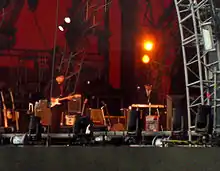
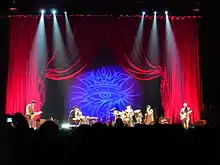
For a two and a half year period, between 2003 and 2006, Dylan ceased playing guitar, and stuck solely to the keyboard during concerts. Various rumors circulated as to why Dylan gave up guitar during this period, none very reliable. According to David Gates, a Newsweek reporter who interviewed Dylan in 2004, "basically it has to do with his guitar not giving him quite the fullness of sound he was wanting at the bottom. He's thought of hiring a keyboard player so he doesn't have to do it himself, but hasn't been able to figure out who. Most keyboard players, he says, like to be soloists, and he wants a very basic sound."[10] Dylan's touring band typically features two guitarists along with a multi-instrumentalist who plays pedal & lap steel, mandolin, banjo, violin and viola. From 2002 to 2005, Dylan's keyboard had a piano sound. In 2006, this was changed to an organ sound. At the start of his Spring 2007 tour in Europe, Dylan once again began playing guitar. The last time Dylan played an acoustic guitar live was at the White House's Celebration of Music from the Civil Rights concert in 2010.[11] As of the most recent leg of the Never Ending Tour, in fall 2019, he mostly played piano but would also occasionally play songs on electric guitar and take center-stage with just his harmonica and microphone.
Currently, Bob Dylan's band consists of the following members:
- Bob Dylan — vocals, piano, harmonica, guitar
- Donnie Herron — pedal steel, lap steel, electric mandolin, banjo, violin
- Charlie Sexton — lead guitar
- Tony Garnier — bass guitar
- Matt Chamberlain — drums, percussion
- Bob Britt — guitar
During a 2006 interview with Rolling Stone magazine, Dylan spoke about his current band: "This is the best band I've ever been in, I've ever had, man for man. When you play with guys a hundred times a year, you know what you can and can't do, what they're good at, whether you want 'em there. It takes a long time to find a band of individual players. Most bands are gangs. Whether it's a metal group or pop rock, whatever, you get that gang mentality. But for those of us who went back further, gangs were the mob. The gang was not what anybody aspired to. On this record (Modern Times) I didn't have anybody to teach. I got guys now in my band, they can whip up anything, they surprise even me."[12]
Other notable members include Stu Kimball (Guitar from 2004-2018), Denny Freeman (Guitar, Slide Guitar from 2005–2009), Larry Campbell (Guitar, Slide Guitar, Pedal Steel, Banjo, Cittern, Mandolin & Violin from 1997–2004), George Receli (Drums from 2001-2019), Freddy Koella (Guitar from 2003–2004), David Kemper (Drums from 1996–2001), Bucky Baxter (Pedal Steel from 1992–1999), John "J.J." Jackson (Guitar from 1991–1997) and G.E. Smith (Guitar from 1988–1990). Between the years 2003-2004, Tommy Morrongiello, a technician on the tour, would frequently play guitar with Dylan & his Band. Charlie Sexton, who played the guitar from 1999 until 2002, returned as the lead guitarist in Dylan's band for the fall 2009 tour, replacing Denny Freeman. Sexton was in turn replaced by Duke Robillard for the first half of 2013, before returning on July 3, 2013. Sexton was replaced for seven concerts by Colin Linden before returning once again on July 26, 2013.[13][14]
Over the years, many artists have been special guests at shows, playing songs with Dylan & his Band. Artists include Phil Lesh, Jack White, Paul Simon, Ronnie Wood, Bruce Springsteen, Bono, Norah Jones, Willie Nelson, John Mellencamp, Tom Petty, Neil Young, Jimmie Vaughan, Carl Perkins, Elvis Costello, Amos Lee, Patti Smith, Van Morrison, Warren Haynes, Al Kooper, Jorma Kaukonen, Paul James, Kenny Wayne Shepherd, Dave Stewart, Chrissie Hynde, Nils Lofgren, Dave Matthews, Susan Tedeschi, Dave Alvin, Chuck Loeb, Dickey Betts, Bob Weir, Ian Moore, Roger McGuinn, Cesar Diaz, Boyd Tinsley, LeRoi Moore, Doug Sahm, Aimee Mann, Liz Souissi, Ray Benson, Leon Russell, Lukas Nelson, Carlos Santana and Mark Knopfler.
Timeline
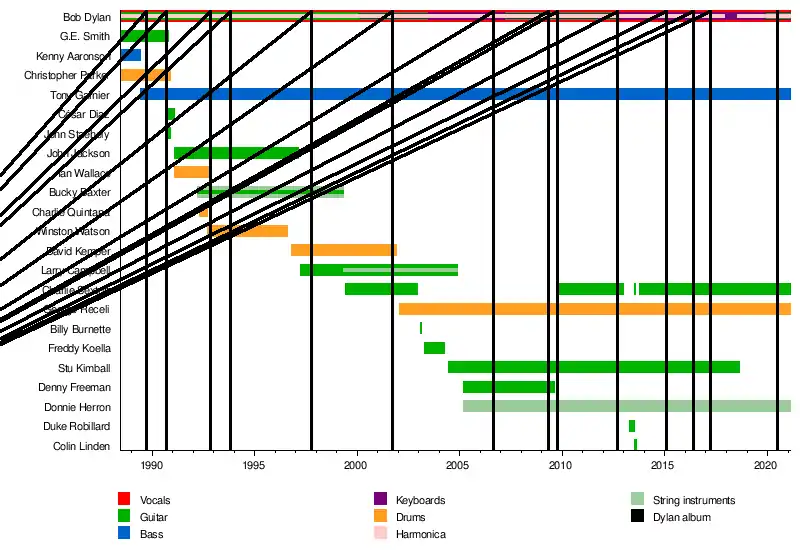
Tours
|
|
|
|
|
Notes
- "Still On The Road: 2019 EU Spring Tour". Bjorner. Retrieved 2019-04-20.
- Hann, Michael (2011-06-12). "Bob Dylan begins his 'never-ending' tour". The Guardian. London. Retrieved 2011-11-26.
- "The Evolution of Bob Dylan". Rolling Stone Magazine. Retrieved 2011-11-26.
- "The Razor's Edge: Bob Dylan and the Neverending Tour". Good Reads. Retrieved 2011-11-26.
- "Still On The Road". Bjorner. Retrieved 2011-11-26.
- "Still On The Road: 2007 US Fall Tour". Bjorner. Retrieved 2011-11-26.
- Gray, The Bob Dylan Encyclopedia, 2006, pp. 173–174
- Lister, David (May 29, 1997). "Bob Dylan in hospital after heart scare". London: Independent. Retrieved 2011-11-26.
- "Bob Dylan Never Ending Tour Diaries". Retrieved March 30, 2017.
- "Talking About Chronicles". Right Wing Bob. Archived from the original on 2016-03-03. Retrieved 2011-11-26.
- Greene, Andy; Greene, Andy (2013-09-10). "Bob Dylan Plays for Obama". Rolling Stone. Retrieved 2021-02-04.
- "The Genius of Bob Dylan". Rolling Stone. 2006-08-23. Retrieved 2011-11-26.
- "Bob Dylan welcomes guitarist Charlie Sexton back into his band". Rolling Stone. 2009-08-26. Retrieved 2011-11-26.
- "Duke Robillard joins Bob Dylan tour". Epiphone. 26 March 2013. Retrieved 26 March 2013.
- VanderWiel, Emily. "Bob Dylan Announces April 2020 Japan Tour". Live for Live Music. Live for Live Music. Retrieved 30 October 2020.
- "Bob Dylan Concerts in Japan Canceled as Coronavirus Spreads". US News. US News. Retrieved 30 October 2020.
- Monroe, Jazz. "Bob Dylan Announces 2020 U.S. Tour". Pitchfork. Pitchfork Media. Retrieved 30 October 2020.
- Legaspi, Althea. "Bob Dylan Cancels U.S. Summer Tour in 'Interest of Public Health and Safety'". Rolling Stone. Rolling Stone. Retrieved 30 October 2020.
References
- Gray, Michael (2006). The Bob Dylan Encyclopedia. Continuum International. ISBN 978-0-8264-6933-5.
- Muir, Andrew (2001). Razor's Edge: Bob Dylan & the Never Ending Tour. Helter Skelter. ISBN 978-1-900924-13-9.
- Muir, Andrew (2013). One More Night: Bob Dylan's Never Ending Tour. Andrew Muir. ISBN 978-1-48263-2361.
External links
![]() Quotations related to Never Ending Tour at Wikiquote
Quotations related to Never Ending Tour at Wikiquote
![]() Media related to Never Ending Tour at Wikimedia Commons
Media related to Never Ending Tour at Wikimedia Commons
- BobLinks – Comprehensive log of concerts and set lists with categorized link collection
- Bjorner's Still on the Road – Information on all known recording sessions and performances by Dylan
- Le-cartographe.net/ Maps of the Never Ending Tour